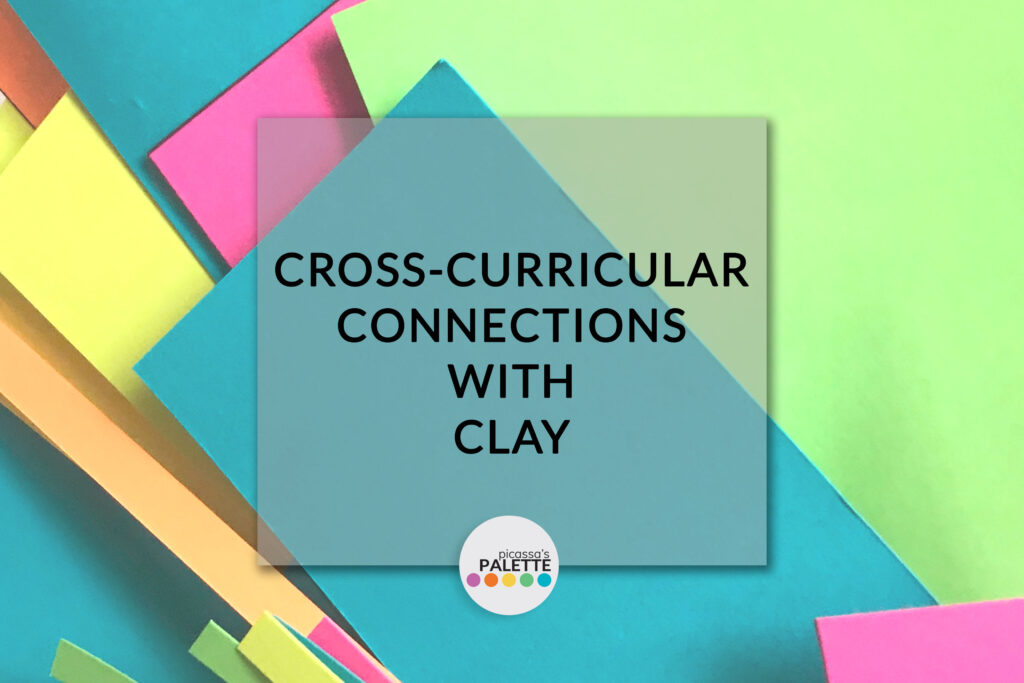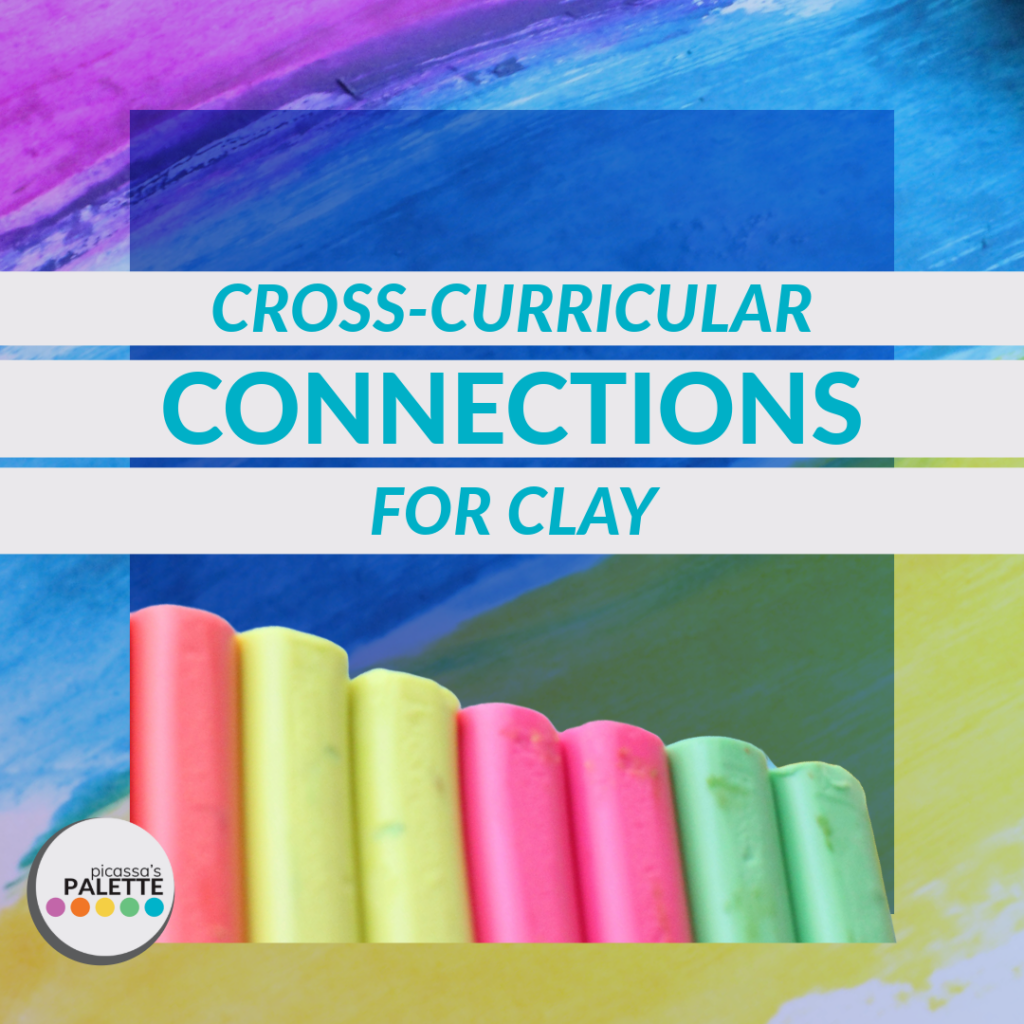
What Is It?
“Cross-Curricular Connection” in Art Ed means blending artistic activities into lessons from other subjects. It involves combining artistic activities with concepts from Math, Science, Language Arts, History, Social Studies, etc. for a deeper understanding across a wide-variety of topics.
What Are Some Benefits of Incorporating Clay in Education?
The integration of art concepts and materials- especially clay – into different academic areas encourages the development of a variety of beneficial skills in learners.
It’s Versatile.
Clay is one of the most versatile media for general ed connections. It can provide an introductory /exploratory jump-off point to introduce a new unit or concept. Alternatively, it can provide for a more memorable culminating learning experience via projects which solidify the learning of specific unit-related concepts.
It Provides Hands-on Learning Opportunities
This integration of Clay media into different academic areas allows textural exploration for both the youngest artists AND older artists- who commonly aren’t quite used to getting their hands ‘dirty’.
It Enhances Tactile Development and Sensory Motor Development
It also enhances students’ tactile and sensory development via hands-on, individual learning experiences. The frequent use of screens nowadays can severely limit their motor skills to tapping/swiping, but to most teachers- it’s obvious kids crave moving their fingers as they build fine motor skills — just look at the increasing popularity of fidget spinners and tiny mini-toys in recent years!
Which Subjects Are Easily Paired with Clay?
Math Connections with Clay
As a physical material which takes up space and dimension, clay connects naturally to Mathematics- making geometric shapes and 3D forms come to life. Rather than viewing photos on screens– 2D and flat–working with a 3D material naturally builds perceptional skills necessary for estimation, measurement and proportionality. The use of clay modeling also lends itself well toward an introduction to basic mathematical concepts – like volume, scale and symmetry.
Natural Science Connections to Clay
As students learn about the scientific composition of clay, they can observe and identify which elements and minerals are in the mix, and how its appearance can be affected. Applications of chemistry can be investigated by clay-specific processes- like drying, firing, and glazing. In these processes, students examine how clay is affected by temperature and humidity. By experimentation with clay, learning the science behind it becomes a hands-on adventure.
Social Studies and Its Clay Connections
Clay is a useful tool for students to explore their own connection to community, to history and to the cultures of the past.
Art can be a powerful way to empower students and enhance their community engagement, building strong citizenship qualities.
Collaborative clay projects can provide a tangible option for fostering a connection between students and their ability to respect community values- especially if paired with a service-learning based curriculum unit.
By examining the use of art to represent or meet needs of citizens within their surrounding community, upholding shared values in the community while reinforcing positive character-building qualities.
Clay-based projects can engage students with history as they explore pottery and ceramic styles used by local artisans. This fosters not only an appreciation for their craftsmanship, but also connects them to the cultural heritage of their community. When lessons emphasize the legacy of the art, historic traditions are preserved.
Discovering various decorative and functional creations of the past, can provide students with a tangible link to the past– highlighting the importance of passing down artistic legacies as culture and heritage… After all, clay vessels are some of the oldest ‘inventions’ of humanity! Through the investigation of historical artwork from various civilizations and generations, students explore learning concepts which span widely across both historical timelines and political boundaries.
In addition to examining the clay of cultures, clay itself is easily used as a medium to represent boundaries and features — such as natural and/or political geography, both on large and small scales. Incorporating clay into the study of geography offers a hands-on approach to helping students better understand the physical and political landscape. Students can construct, manipulate and observe three-dimensional maps, illustrating geographical features and boundaries themselves. This interactive method enhances their comprehension of spatial relationships, making (frequently abstracted) geographical concepts more tangible.
Clay In Language Arts and Integrations Into Literacy
Young artists build their literary capabilities and storytelling skills through their clay constructions. By recreating sculptural scenes from literature, older students can review and apply concepts of storytelling elements such as setting, plot, and characterization.
With a fresh opportunity to invent their own stories and characters, students of all ages can use and review their knowledge of text-based concepts by gaining basic (or, even an increasingly in-depth) experience with authorship- including and applying literary ideas like conflict, action, resolution, etc.
Cross-curricular clay projects build student vocabulary range by offering deep linguistic enrichment. Clay and art-based subject connections enhance students’ application of both general- and content-specific terms, through class discussions or written responses, as they summarize the process, retell the sequence and recall the techniques used along the scope of their projects.

HOW?
Tips for Implementing Cross-Curricular Clay Projects
Incorporating concepts which students are currently studying allows implementing the cross-curricular connections to integrate more smoothly. As another option, teachers can also “work ahead” — with an aim to pique student interest in the upcoming material.
By providing more concrete learning experiences, increasingly complicated concepts are better supported — specifically helpful when the content requires a build-up to more abstract concepts.
However, it’s also smart to consider typical age-appropriate skills and capabilities at the intended grade level range to balance expectations for learning the desired techniques along with the typical developmental level of the student and the targeted comprehension level of the subject content.
While incorporating the cross-curriculum connections, collaboration with other subject teachers is highly necessary, but communication can be especially challenging for specialists whose schedule typically lacks availability during planning times across different grade-levels and subject-specific department meetings.
Accenting or complementing content of the currently embedded state or local curriculum allows for a more seamless integration of art-based connections across subjects.
If there’s a yearlong outline (aka scope and sequence) available with content standards, or a list of unit contents for the grade level and/or subject you’re trying to connect with, planning will be much easier and connections can overlap more easily.
Recommended Reading, Related Books, and Content-Based Vocabulary Lists, all provide other options for brainstorming ideas to connect.
TRY IT!
The benefits of using clay-based cross-curricular connections include its versatility and its natural ability to intrigue students. Incorporating art within other subjects fosters opportunities for self-expression as it provides students with a multidimensional support for their learning experiences.
I encourage you to explore these ideas, and as you implement, freely sprinkle in the basics of your own curriculum needs as you remember to allow for student creativity by being open to increasing levels of their artistic freedom.
This cross-curricular approach of integrating art into various academic areas provides a more comprehensive and well-rounded learning experience, as it helps your students better understand both Art and the connected subjects.
… Have you done cross-curricular collaborations with teachers of other subjects? Share your stories and experiences with art integration in gen ed classrooms in the comments below!